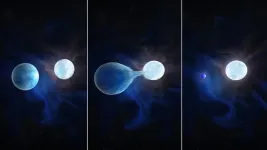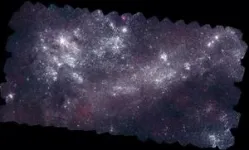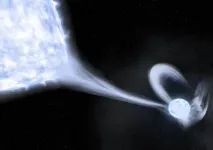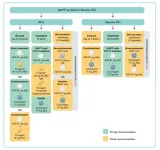(Press-News.org) Astronomers at the University of Toronto have discovered a population of massive stars that have been stripped of their hydrogen envelopes by their companions in binary systems. The findings, published today in Science, shed light on the hot helium stars that are believed to be the origins of hydrogen-poor core-collapse supernovae and neutron star mergers.
For over a decade, scientists have theorized that approximately one in three massive stars are stripped of their hydrogen envelope in binary systems. Yet, until now, only one possible candidate had been identified.
“This was such a big, glaring hole,” says co-lead author Maria Drout, an Assistant Professor in the David A. Dunlap Department of Astronomy & Astrophysics and a Dunlap Institute for Astronomy & Astrophysics Associate at the University of Toronto.
“If it turned out that these stars are rare, then our whole theoretical framework for all these different phenomena is wrong, with implications for supernovae, gravitational waves, and the light from distant galaxies,” Drout says. “This finding shows these stars really do exist.”
“Going forward, we are going to be able to do much more detailed physics with these stars,” Drout says. “For example, predictions for how many neutron star mergers we should see are dependent on the properties of these stars, such as how much material comes off of them in stellar winds. Now, for the first time, we’ll be able to measure that, whereas people have been extrapolating it before.”
Binary stripped stars have been previously evoked to explain why a third of core-collapse supernovae contain much less hydrogen than a typical explosion of a Red Supergiant star. Drout and her colleagues propose that these newly discovered stars will eventually explode as hydrogen-poor supernovae. These star systems are also thought to be necessary to form neutron star mergers, like those that emit gravitational waves detected from Earth by the LIGO experiment.
In fact, the researchers believe that a few objects in their current sample are stripped stars with neutron star or blackhole companions. These objects are at the stage immediately before they become double neutron star or neutron star plus blackhole systems that could eventually merge.
“Many stars are part of a cosmic dance with a partner, orbiting each other in a binary system. They're not solitary giants but part of dynamic duos, interacting and influencing each other throughout their lifetimes,” says Bethany Ludwig, a PhD student in in the David A. Dunlap Department of Astronomy & Astrophysics at the University Toronto and the third author on this paper. “Our work sheds light on these fascinating relationships, revealing a universe that is far more interconnected and active than we previously imagined.”
“Just as humans are social beings, stars too, especially the massive ones, are rarely alone,” Ludwig says.
As stars evolve and expand to become red giants, the hydrogen at the outer edges of one can be stripped by the gravitational pull of its companion—leaving a very hot helium core exposed. The process can take tens of thousands, or even hundreds of thousands, of years.
Stripped stars are difficult to find because much of the light they emit is outside of the visible light spectrum and can be obstructed by dust in the universe or outshone by their companion stars.
Drout and her collaborators began their search in 2016. Having studied hydrogen-poor supernovae during her PhD, Drout set out to find the stripped stars thought to be at the heart of them during a NASA Hubble Postdoctoral Fellowship at the Observatories of the Carnegie Institution for Science. She met fellow co-author Ylva Götberg, now Assistant Professor at the Institute of Science and Technology Austria (ISTA), at a conference, who had recently built new theoretical models of what these stars should look like.
Drout, Götberg, and their collaborators designed a new survey to look in the ultraviolet part of the spectrum where extremely hot stars emit most of their light. While invisible to the naked eye, ultraviolet light can be detected by specialized instruments and telescopes.
Using data from the Swift Ultra-Violet/Optical Telescope, the researchers collected brightnesses for millions of stars in the Large and Small Magellanic Clouds, two of the closest galaxies to Earth. Ludwig developed the first wide-field UV catalog of the Magellanic Clouds and used UV photometry to detect systems with unusual UV emissions, signaling the possible presence of a stripped star.
They carried out a pilot study of 25 objects, obtaining optical spectroscopy with the Magellan Telescopes at Las Campanas Observatory between 2018 and 2022. They used these observations to demonstrate that the stars were hot, small, hydrogen-poor, and in binary systems—all consistent with their model predictions.
Currently, the researchers are continuing to study the stars identified in this paper and expanding their search to find more. They will be looking both within nearby galaxies and within our own Milky Way with approved programs on the Hubble Space Telescope, the Chandra X-Ray Telescope, the Magellan Telescopes, and the Anglo-Australian Telescope. As part of this publication, all theoretical models and data used to identify these stars have been made public and available to other scientists.
Collaborating institutions include the University of Toronto, the Observatories of the Carnegie Institution for Science, Max-Planck-Institut für Astrophysik, Anton Pannekoek Institute for Astronomy, Dunlap Institute for Astronomy & Astrophysics, and Steward Observatory.
About the Dunlap Institute for Astronomy & Astrophysics
The Dunlap Institute for Astronomy & Astrophysics in the Faculty of Arts & Science at the University of Toronto is an endowed research institute with over 80 faculty, postdocs, students, and staff, dedicated to innovative technology, groundbreaking research, world-class training, and public engagement.
The research themes of its faculty and Dunlap Fellows span the Universe and include: optical, infrared and radio instrumentation, Dark Energy, large-scale structure, the Cosmic Microwave Background, the interstellar medium, galaxy evolution, cosmic magnetism and time-domain science.
The Dunlap Institute, the David A. Dunlap Department of Astronomy & Astrophysics, and other researchers across the University of Toronto’s three campuses together comprise the leading concentration of astronomers in Canada, at the leading research university in the country.
###
.
END
DNA analysis of a 19th-century dog, paired with traditional knowledge acquired through interviews, have together provided new insights into the decline of Coast Salish “woolly dogs” – an extinct Indigenous dog once bred for its unique woolly coat. Dogs were introduced to the Americas at least 15,000 years ago and have been ubiquitous in Indigenous societies across the continents for thousands of years. Coast Salish peoples – a group of Indigenous societies that lived in the Salish Sea region of the Pacific Northwest (PNW) – kept several different types of dogs, including a special lineage of “woolly ...
Science has named the development of glucagon like peptide-1 (GLP-1) agonists and this year’s discovery that these drugs can blunt obesity-associated health problems as its 2023 Breakthrough of The Year. Although obesity’s causes span genetic, physiological, environmental, and social factors, as a medical problem, obesity’s risks can be life-threatening – including heart disease, diabetes, arthritis, liver disease, and certain cancers. Drug treatments for obesity have had “a sorry past, one often intertwined with social pressure to lose weight and the widespread belief that excess weight reflects weak willpower,” writes ...
Genomic analyses reveal illegal pangolin trafficking routes from origins in Africa to markets in Asia, researchers report. The approach offers new opportunities to monitor pangolin poaching in near real-time, allowing for targeted and more effective anti-trafficking measures. The illegal wildlife trade is a significant driver of global biodiversity loss. Of all the species poached and traded, the white-bellied pangolin (Phataginus tricuspis) is the world’s most trafficked mammal and is at risk of extinction. Pangolins are in high demand in Asia because their scales are believed, without scientific support, ...
Combining a flexible solar cell with an electrocaloric device, researchers have created solar-powered clothing that allows the body to adapt dynamically to changes in ambient temperature, according to a new study. The new device could help guarantee the safety and comfort of the human body amid fluctuating environmental temperatures and even extend survivability in extreme environments, like those in outer space or other planets. Clothing is the most common way humans regulate their body temperature relative to the environment. However, it is normally focused on keeping an individual either warm or cool. The ability of clothing to ...
Supernovae–stellar explosions as bright as an entire galaxy–have fascinated us since time immemorial. Yet, there are more hydrogen-poor supernovae than astrophysicists can explain. Now, a new Assistant Professor at the Institute of Science and Technology Austria (ISTA) has played a pivotal role in identifying the missing precursor star population. The results, now published in Science, go back to a conversation the involved professors had many years ago as junior scientists.
Some stars do not simply die down, but explode in a stellar blast that could outshine ...
The ‘Nature Restoration Law’ (NRL) requires member states of the EU to implement restoration measures on at least 20 per cent of land and marine areas by 2030, and in all ecosystems in need of restoration by 2050. This includes specific targets to rewet peatlands and to increase pollinator populations. The NRL has already overcome various hurdles: most recently, it was approved by the EU Parliament’s Environment Committee, after delegations of the Parliament and the Council negotiated the final text.
But will the regulation really achieve its aims? The authors, including scientists leading large European projects on ...
Philadelphia, December 14, 2023 – The updated Canadian Cardiovascular Society (CCS)/Canadian Association of Interventional Cardiology (CAIC) antiplatelet therapy guidelines for primary and secondary prevention of atherosclerotic cardiovascular disease (ASCVD) provide recommendations based on the latest randomized evidence available in the literature. Updated by a panel of national experts, these new evidence-based guidelines appear in the Canadian Journal of Cardiology, published by Elsevier.
ASCVD, also known as ischemic heart disease (coronary artery ...
A new Rice University study of the remains of prehistoric and modern African antelopes found that AI technology accurately identified animals more than 90% of the time compared to humans, who had much lower accuracy rates depending on the expert.
Composite images of teeth from five different antelope tribes analyzed and identified by artificial intelligence. Photo courtesy of Manuel Domínguez-Rodrigo.
Identifying these animals and their habits helps paint a broader picture of ancient ecosystems, and with the assistance of this new technology, it can be done with more speed and accuracy than previously done by paleontologists, ...
As church membership declines across the United States, a new study from Rice University’s Boniuk Institute for the Study and Advancement of Religious Tolerance finds that working women do not feel supported by their clergy and churches, regardless of whether they’re involved with a more conservative or liberal congregation.
“The Limits of Congregational Support for Working Women” is part of a larger study of faith at work funded by Lilly Endowment Inc. It ...
The Supplemental Nutrition Assistance Program (SNAP) is the nation’s largest nutrition program, helping 41 million participants afford “nutritious food essential to health and well-being.”
But a new study from the University of Notre Dame found that SNAP participants in low-income households may not be able to meet the nutrition levels set by the Dietary Guidelines for Americans (DGA).
The case study set out to examine whether SNAP participants would be able to afford a healthy diet based on DGA’s recommended nutritional values. The DGA was created by the U.S. Departments of Agriculture and Health and Human ...






